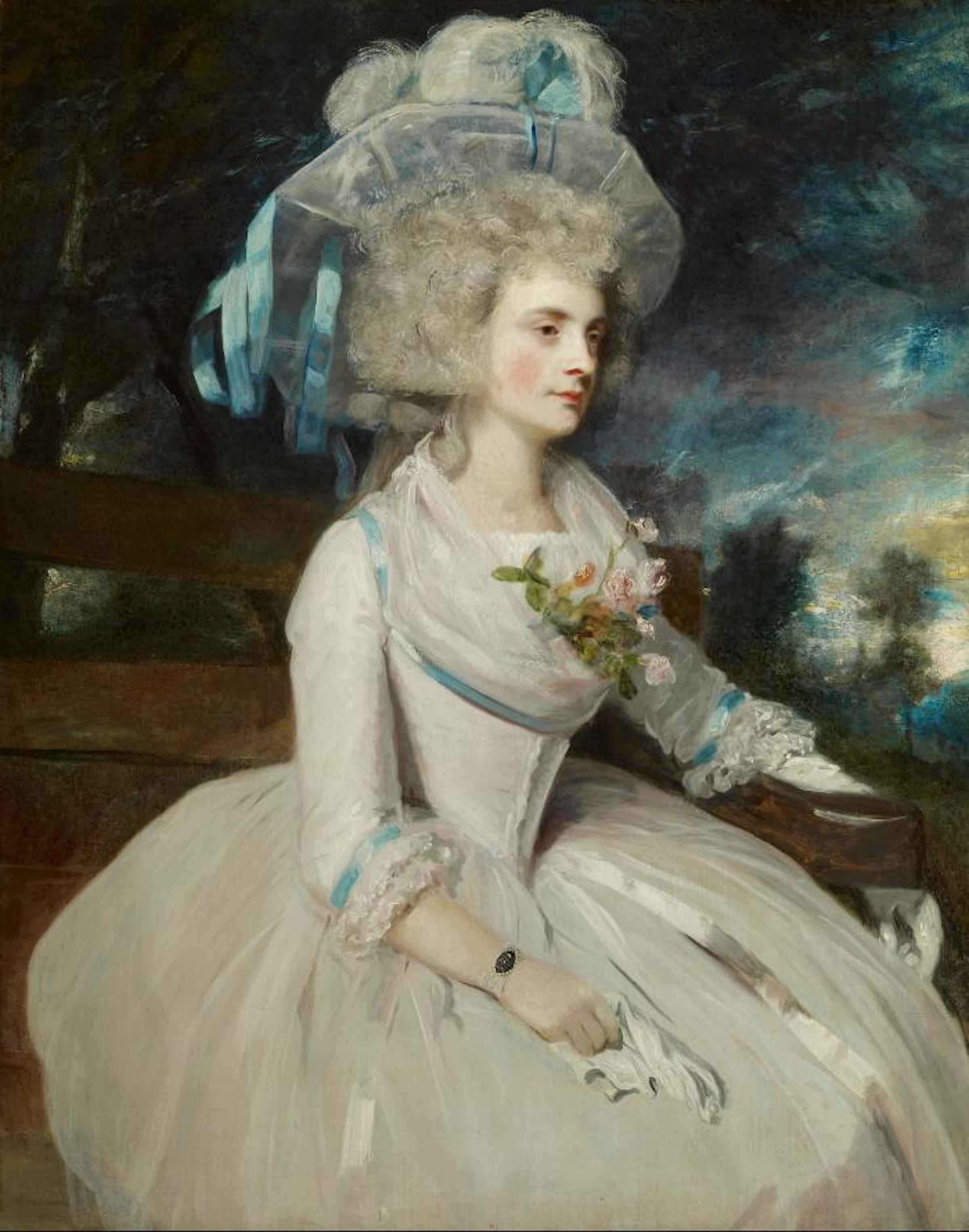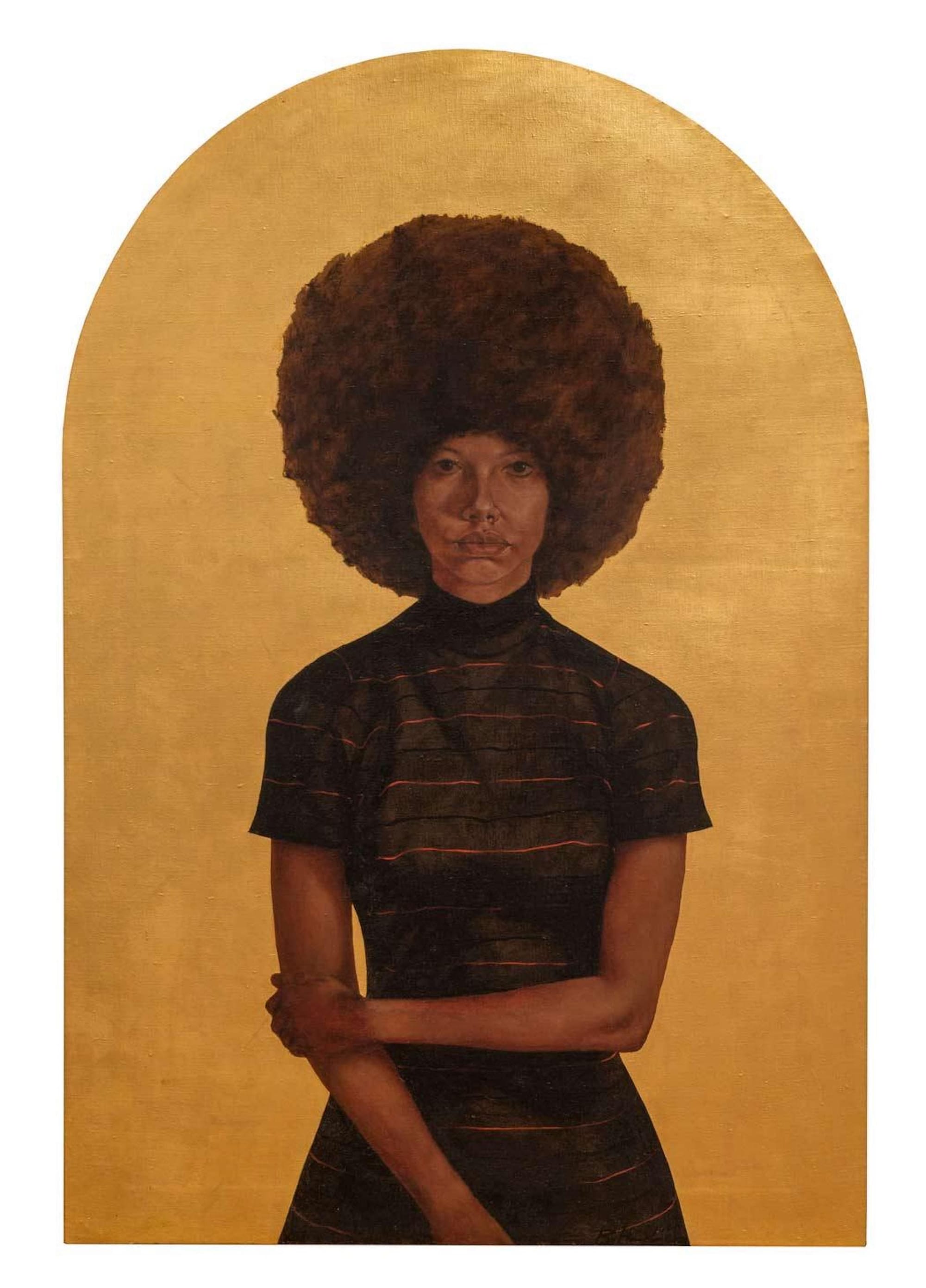By Adam Wassilchalk and Betsy Kim
Barkley L. Hendricks: Portraits
The Frick Madison
945 Madison Ave. at 75th Street
New York City
Through Jan. 7, 2024
Taking advantage of free tickets from NYC’s culture pass program for New York Public Library card holders, we viewed Barkley Hendricks’ 14 paintings, the first solo show of a Black artist or an artist of color in the Frick’s history. Afterward, we went for burgers and discussed the power of Hendricks’ art and whether the exhibition, curated by Frick curator Aimee Ng and consulting curator Antwaun Sargent, reinvigorated the museum’s relevance.
Our excerpted conversation follows.
Adam: Lawdy Mama, the first artwork welcoming people to the exhibition, was an image I don’t see elsewhere, a black subject on a gold-leaf background. The subject is Barkley Hendricks’ relative. To me, this is the kind of art you would make for your king or queen. I found the level of care, value, and dignity for someone who is just like your cousin, really cool and interesting.
Betsy: It harkened back to Byzantine or Renaissance religious icons, with her hair as a halo and the arched frame of the canvas. I read that Hendricks had spent time in Europe, studying the classical artists, and the Frick was one of his favorite museums. The Frick states the portraits in this show incorporated the Old Masters’ techniques, with which Hendricks created his own style that indelibly influenced Black figurative painting and American portraiture. I saw an obvious nexus with Lawdy Mama. But what was the main message you gathered that packed a punch?
Adam: If this was how they’re going to get new audiences —I ’m probably that new audience. I would not have been at the Frick Madison if it were not for this exhibition. I had never even heard of the Frick before! I probably would not have come, but I thought that this exhibit is something I would love to review with you.
Betsy: I’m so glad you suggested it because I wasn’t familiar with Barkley Hendricks, so I became a new audience for that painter! This exhibition felt in sync with today’s issues as it was clearly about race and culture in society. Right beyond Lawdy Mama, in the room before entering the main space of the exhibition, there were paintings that the Frick is known for from the late 1700s: Thomas Gainsborough’s Frances Duncombe and Joshua Reynolds’ Lady Skipwith.
The Frick Collection opened in 1935. It is now temporarily subletting the Breuer building from the Metropolitan Museum of Art (which leased the space from the Whitney). While renovating its permanent location, at 1 E. 70th St. and Fifth Ave., the Frick saw this as an opportunity to expand its mission and inclusivity.The Frick took a sharp departure from its ordinary course of business for almost 90 years, by moving into the brutalist architectural structure at 945 Madison Ave., and featuring Hendricks’ work inside.

Adam: The main thing I questioned was whether they were really putting that extreme white makeup on themselves. It’s almost silly to think about. I felt they did not look human. Lady Skipwith looked like porcelain. But it goes to show value; who gets valued as subjects in these portraits? Porcelain does — not ebony.
Betsy: Even dating back to the first Queen Elizabeth’s time, women painted their faces with very white makeup that was dangerous because it was filled with lead. The whiteness of skin represented affluence, and being in the upper class, how women would want to be seen and depicted in portraits. And her huge, grey bouffant was also the height of fashion for society women. Later, in the Victorian era, women were even drinking arsenic potions to get a more porcelain look to their skin. They would look pale and translucent because the arsenic was killing their blood cells. That ghostly, dying look was happening with good reason!
Adam: Even white people aren’t white enough to be portrait subjects without putting on that makeup or taking arsenic? Unhinged behavior! But even today there are many examples of people pursuing “beauty” or aesthetics in ways that are detrimental to their health, including hazardous contemporary skin lightening techniques, so I guess I shouldn’t be that surprised.
Betsy: In many cultures, a fairer complexion wasn’t meant as just a racial distinction but signified being in the gentry class, not working out in the fields. Of course, historically, it can be related. Even with the term “gentleman farmer,” I doubt Thomas Jefferson was out there, tilling the lands and hoeing the fields — himself.
Reynolds was the president of the Royal Academy of Arts in London and the wealthy families of high-society women would commission their portraits. Reynolds and Hendricks studied Italian Renaissance painters as well as Old Masters, like Rembrandt and Van Dyck. Reynolds is credited with bringing the Grand Manner style of paintings to Britain. I clearly see how he brought this classical, idealized depiction of people to his time and subjects, like with Lady Skipwith. But did you see that style adopted from Europe, transformed and carried forward in Hendricks’ work?
Adam: I don’t know If I would say Hendricks is directly emulating that Grand Manner style of portraiture, based on the few I’m seeing here. But I can see that he might be putting his own contemporary remix on the concept.

Adam: With Miss T, she wasn’t looking at the viewer or the artist. Was she looking at something else? The subject, Robin Taylor, was Hendricks’ girlfriend at the time. But in her expression, I wasn’t seeing warmth. I was interested in the meaning of her expression. There’s more aloofness, ice in Miss T’s eyes, which I found intriguing. She has kind of an enigmatic look, similar to but also unlike the Mona Lisa, whose eyes follow you.
No matter how or where you look, his subject in that painting seems to be looking away. Hendricks was also so on point with the fashion for the ‘60s and ‘70s, capturing her hair, the aviator glasses, and pantsuit with bell-bottoms!
The wall text was interesting. It said how some of the paintings came with “good color besides what’s on their canvas.” And Miss T “scared the shit out of my mother when she told her, if she couldn’t have me, no one would.”
Betsy: That was an unusual yet graphic anecdote!
If the painting is trying to capture the essence of a real person, that undeniably is a memorable quote. It heightens how his portraits encapsulated a moment in time and even in Hendricks’ personal history. The way we now have the Black Lives Matter movement, Miss T and the other paintings bring to the Frick Madison the Black Power movement of the 1960s and 1970s. This sense of time struck me especially with Miss T’s quote revealing her personality.
In the Grand Manner style, all the paintings in the exhibition, like Miss T, were full-length, life-size. His use of almost monochromatic color schemes gave the portraits a sculptural, monumental, statuesque, frozen-in-time yet also dynamic quality.
Adam: I’d also be curious to know how Miss T is doing now. Hendricks presumably did not end up with her, as the next painting in the gallery was of his wife, Susan.

Adam: I love chaotic art and to me, this painting Ma Petite Kumquat feels chaotic. Why are there Christmas present bows on her shoes? What is that bowtie doing? Is that a lampshade in her hand?
When you see a piece of art, a lot of artists like being clean and orderly. I think that’s prized and valued. When artists choose to go against that, I find it fun and entertaining. I feel the world would be boring if all art were clean, orderly, and perfect, whatever that means.
Betsy: Hendricks’ painting of his wife reminded me of Kehinde Wiley’s portrait of President Barack Obama, commissioned by the Smithsonian’s National Portrait Gallery. There’s a modern, abstract quality to it. And there’s also a chaotic element as the president is seated in an antique-looking wooden chair, in the middle of dense foliage with flowers. Recalling the Obama painting, I can see Hendricks’ influence on subsequent Black portraiture.
Adam: I was also thinking about the labor behind the art, where he kept adding more props. I liked the dots created by using the eraser end of a pencil dipped in paint, that decorated the top quarter of the background. It reminded me of how I would make pencil dots when I was bored in class, doodling on tests that I’d finished. I love that Hendricks combines a lot of different odd components, bringing them to portraiture.
Betsy: Susan’s big hair and the leg warmers placed the painting in the 1980s. Hendricks’ explanation that he added the kumquat because the painting needed additional warm color, made the dots and added accessories like the bowtie, muff, leg warmers and Christmas bows seem disruptively random to me. The “chaos” as you worded it, left me with the uncertainty of unanswered questions. Perhaps that’s a true portrait, leaving questions and quirky unknowns about the people we are close to — our friends and family.
Seeing the Old Masters’ footprints in his art such as Ma Petit Kumquat, tying it to the Frick Collection, felt far less obvious to me. Maybe it’s like a family gene pool hundreds of years later, visible in some people, such as in Lawdy Mama but less visible in others. Maybe that didn’t matter as the beautiful works document a significant influence in portraiture. With its nearly all Black subjects, the exhibition itself may for some Caucasian visitors, build a more visceral understanding of what it has been like for some Black folks over the years, coming to the Frick.
Adam: There was a trend in all the paintings we saw. These were ordinary people who were getting the portraits. I think that’s important compared to the Reynolds painting, where there was a very intentional process of beautification. Hendricks’ art is a “come as you are” type portraiture. It’s about respecting your community. These are people on the scene in everyday life, people whom you are falling in love with, who are friends and classmates. He’s trying to capture the beauty of the folks he’s seeing in his everyday life. I’m seeing a message that all these ordinary people are worthy of portraits.
Up Next for Adam: He’ll be seeing Urban Heat perform at the Mercury Lounge NYC.
Up Next for Betsy: She’ll be reviewing Paul Vlachos’ photo exhibition PRIVATE/NYC at Art Cake in Brooklyn.






